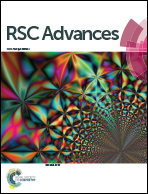Synthesis and characterization of protic ionic liquids as thermoelectrochemical materials†
Abstract
This unique work reports on the thermoelectrochemical potential of protic ionic liquid (PIL)-based electrolytes coupled with the I−/I3− redox couple. Two series of protic ionic liquids based on secondary and/or tertiary ammonium cations with the trifluoroacetate, methanesulfonate, trifluoromethanesulfonate and tosylate anions were synthesized for thermoelectrochemical cells. The complete study on PILs was carried out to determine the nature and efficiency for the generation of voltage through the electrochemical effect. The investigation was executed in a temperature range between room temperature and 90 °C. PILs show lower thermal conductivity and good ionic conductivity which leads to the success of good thermoelectric materials. The outcome was positive as our proposed PILs showed higher Se values of 420 μV K−1 obtained for TEHA TFMS than the reported values of the same I−/I3− redox couple. The most favorable thermoelectric figure of merit value (949.46 × 10−6) was achieved by BEHA TFMS. The power and the current output of the studied PILs are higher than those of some aprotic ionic liquids (AILs) reported.


 Please wait while we load your content...
Please wait while we load your content...